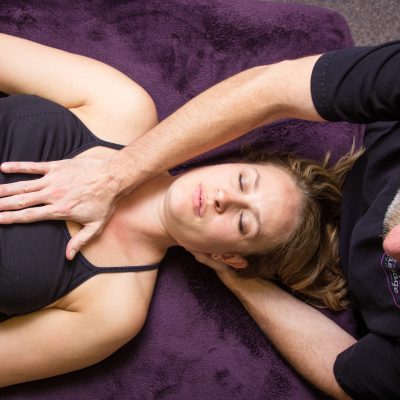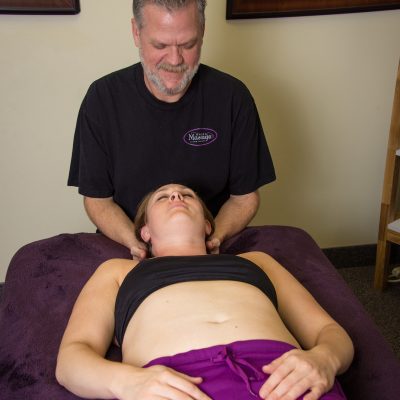Myofascial Release
Fascia is the tough connective tissue which spreads throughout the body in a three-dimensional web from head to foot without interruption. Myofascial Release consists of gentle application of sustained pressure into the fascial restrictions. Pressure applied slowly, along with stretches, will allow the fascia to elongate.
Specify “Myofascial Release” with Dave when booking your appointment.
NOTE: Dave is trained in the John F. Barnes method of Myofascial Release and he suggests visiting the John Barnes website.
Alison and Brenna, also incorporate MFR into their massage sessions along with other techniques.
Need Relief?
Experiencing any of the following Conditions or Diagnoses? This is only a partial list of the conditions that we can help.
- Back Pain
- Bladder Problems (Urgency, Frequency, Incontinence, Overactive Bladder, Leakage)
- Birth Injuries
- Bulging Disc
- Bursitis
- Carpal Tunnel Syndrome
- Cerebral Palsy
- Cervical and Lumbar Injuries
- Chronic Fatigue Syndrome
- Chronic Pain
- Degenerative Disc Disease
- Endometriosis
- Emotional Trauma
- Fibromyalgia
- Frozen Shoulder (Adhesive Capsulitis)
- Herniated Disc
- Headaches or Migraines
- Infertility
- Interstitial Cystitis
- Menstrual Problems
- Myofascial Pain Syndrome
- Neck Pain
- Osteoarthritis
- Pelvic Pain
- Plantar Fascitis
- Pudendal Nerve Entrapment
- Scars (hypertrophic, hypersensitive, painful, burn scars, mastectomy scars)
- Sciatica
- Scoliosis
- Shin Splints
- Tennis Elbow
- Tinnitus (Ringing of the ears)
- TMJ Syndrome
- Trigeminal Neuralgia
- Whiplash
Back Pain
What is it?
Back Pain is one of the most common disorders in the world. Over 33 million Americans suffer from back pain each year and are frustrated by the lack of improvement.
How can MFR help?
Myofascial Release is extremely helpful in reducing back pain, restoring the motion and flexibility of the entire spine by treating the front and back three-dimensionally and the associated pelvis which is considered to be the foundation of the spine.
Bladder Problems (Urgency, Frequency, Incontinence, Overactive Bladder, Leakage)
What is it?
Partial or complete loss of bladder control when coughing or sneezing, feeling the need to frequently urinate, or inability to reach the toilet in time.
How can MFR help?
MFR decreases the tightness and spasm in the pelvic floor muscles and tissues surrounding the bladder to regain normal function.
Birth Injuries
What is it?
Birth Injuries is a wide category that includes any trauma that a baby may experience during the birthing process or immediately after being born. Use of forceps, posterior births, breach births, and anything that can add stress or physical trauma to the newborn is considered a birthing trauma.
How can MFR help?
By addressing these physical traumas immediately after the newborn has experienced them, decreases their ability to have a long-term cumulative effect in the baby’s body. These restrictions can multiply and cause a variety of other debilitating issues for the child further into his/her development.
Bulging Disc
What is it?
Distension of the fibrous material that makes up the disc, or the cushioning tissue found between each vertebrae in the spine, resulting from direct trauma, heavy lifting, repetitive activities, or compression from tight muscles surrounding the spine. Bulging discs can cause neck pain, back pain, and/or radiating pain into the arms and legs.
How can MFR help?
MFR decreases tightness in the tissues surrounding the spine to prevent further herniation and decrease pain and symptoms.
Bursitis
What is it?
Inflammation of the fluid filled sac found between bones and muscles resulting in pain and decreased motion.
How can MFR help?
MFR decreases tightness of the tissues surrounding the bursa to alleviate pressure, restore full motion, and eliminate inflammation of the bursa.
Carpal Tunnel Syndrome
What is it?
Tightness in the neck, chest, and wrist resulting in compression and swelling of the nerves that feed the hand resulting in numbness, tingling, and pain in the fingers. Carpal Tunnel Syndrome is usually caused by repetitive movement of the arms and hands.
How can MFR help?
MFR decreases the tightness of the tissues in the chest, neck, and arms to allow the nerves to glide easily and freely to eliminate symptoms.
Cerebral Palsy
What is it?
Cerebral Palsy is a general term used to describe a dysfunction of a portion of the brain called the cerebrum which can affect muscle tone, active movement, cognition, and functional mobility like walking or sitting. It most often occurs at or before birth from a lack of oxygen to the developing fetus or from birth trauma. Cerebral Palsy can be associated with other problems such as balance and coordination issues, seizures, speech, learning disabilities and mental retardation. Muscle tone may be low or overly tight/stiff and movement hard to control or uncoordinated. Over time, abnormal tone and lack of functional mobility can cause joint contractures and pain from excessive stress on the joints associated with abnormal movement patterns.
How can MFR help?
Myofascial Release can help to improve soft tissue mobility, improve muscle tone, decrease abnormal movement patterns and increase overall functional mobility. Although Myofascial Release does not eliminate the dysfunction in the brain, it does help to minimize tightness in the fascial system to help improve overall mobility, flexibility and function. Myofascial Release can also help to eliminate seizures and the need for seizure medications, prevent or slow joint contractures, improve posture, and decrease pressure within the joints. Myofascial Release should be part of a comprehensive treatment program for individuals with cerebral palsy. It is especially indicated during growth spurts, a significant loss in functional mobility, or if seizure activity returns or increases.
Cervical and Lumbar Injuries
What is it?
Cervical and Lumbar Injuries can occur from a variety of reasons. Since the spine bears a majority of the body’s weight, fractures and misalignment can cause excessive pressure and pain in the cervical and lumber regions of the body.
How can MFR help?
MFR helps to alleviate tightness and restore motion and function by decreasing he pressure cause by tight connective tissues.
Chronic Fatigue Syndrome
What is it?
Severe mental and physical exhaustion often associated with widespread muscle and joint pain.
How can MFR help?
MFR decreases tightness and eliminates fascial tissue restrictions to eliminate pain, restore mobility, and eliminate exhaustion.
Chronic Pain
What is it?
Pain that persists longer than the timeframe of typical healing after injury.
How can MFR help?
MFR decreases fascial restrictions throughout the body, including areas of previous injury to eliminate pain.
Degenerative Disc Disease
What is it?
Dehydration of the cushioning tissue, or disc found between each vertebrae in the spine, resulting from trauma or aging. This loss of the disc’s ability to provide shock absorption leads to either localized or radiating pain into the legs.
How can MFR help?
MFR decreases tightness and fascial restrictions surrounding the problematic discs and vertebrae to prevent further dehydration of the discs and alleviate pain.
Endometriosis
What is it?
Inflammation in the lining of the uterine cavity, or endometrial cells, that leads to pelvic pain or infertility.
How can MFR help?
MFR decreases tightness and fascial restrictions surrounding the pelvis to eliminate inflammation and pain.
Emotional Trauma
What is it?
Trauma resulting from past and/or present events in which emotional reactions have been suppressed.
How can MFR help?
MFR provides a safe, non-judgmental environment in which suppressed feelings can be expressed and released.
Fibromyalgia
What is it?
Chronic, widespread pain often associated with fatigue, sensitivity to light touch, and sleep disturbances.
How can MFR help?
MFR decreases fascial restrictions throughout the body to re-gain optimal flexibility, improve energy levels, restore normal sleeping patterns, and resolve pain.
Frozen Shoulder (Adhesive Capsulitis)
What is it?
Pain and constant difficulty with moving the shoulder due to scarring of the connective tissues in and around the shoulder joint. A frozen shoulder can occur after a fall or repetitive movement of the arm that aggravates and stresses the shoulder.
How can MFR help?
MFR restores mobility to tissue that is scarred or adhered in and surrounding the shoulder joint to restore the ability to fully move the shoulder without pain.
Herniated Disc
What is it?
Rupture of the fibrous material that makes up our disc, or the cushioning tissue found between each vertebrae in the spine, resulting from direct trauma, heavy lifting, repetitive activities, or compression from tight muscles surrounding the spine. Herniated discs can cause neck pain, back pain, and/or radiating pain into the arms and legs.
How can MFR help?
MFR decreases tightness in the tissues surrounding the spine to prevent further herniation and decrease pain and symptoms.
Headaches or Migraines
What is it?
Pain in the head often associated with nausea, dizziness, and neck pain. Can be caused by poorly aligned bones of the head and neck areas, trauma, stress, poor posture, or tightness in the tissues surrounding the brain and spinal cord.
How can MFR help?
MFR decreases tightness and restores mobility of the tissues surrounding the brain and spinal cord, restores optimal postural alignment, and alignment of the bones of the head to alleviate symptoms and prevent future occurrence of headaches and migraines.
Infertility
What is it?
Inability to conceive or carry a pregnancy full term.
How can MFR help?
MFR decreases tissue restrictions in the abdominal area, pelvic floor, and surrounding reproductive organs to enable conception and ensure the healthiest pregnancy possible.
Interstitial Cystitis
What is it?
Urinary frequency, urgency associated with pain in the pelvis and bladder that increases with filling of the bladder. Can also be associated with painful urination, painful intercourse, and pelvic floor dysfunction making it difficult to initiate urination.
How can MFR help?
MFR decreases tightness and fascial restrictions surrounding the pelvis and bladder to restore normal bladder and reproductive organ functions.
Menstrual Problems
What is it?
Irregular or painful menstrual cycles.
How can MFR help?
MFR decreases tightness in tissues of the abdominal area and pelvic floor to achieve regular, pain-free menstrual cycles.
Myofascial Pain Syndrome
What is it?
Chronic pain associated with trigger points, or localized, concentrated areas of pain and tightness throughout the body.
How can MFR help?
MFR decreases tightness in the fascia and muscles to eliminate trigger points and alleviate associated symptoms.
Neck Pain
What is it?
Neck pain can be described as constant or intermittent discomfort originating with the cervical area of the spine. The pain can be located within the neck or can refer into the head, arms or other parts of the body causing pain, numbness, and loss of strength, muscle spasms and mobility.
How can MFR help?
Myofascial Release can help to remove the compression that restrictions can apply to pain sensitive structures in the cervical region and associated structures that cause pain and dysfunction.
Osteoarthritis
What is it?
Pressure and compression in joints resulting in inflammation and wearing away of the cartilage or “cushion” between joint surfaces creating pain and stiffness. Osteoarthritis can be found in many joints of the body, but is commonly found in weight bearing joints such as hips and knees creating weakness and pain.
How can MFR help?
MFR decreases tightness of tissues surrounding joints to alleviate pressure and compression in the joint. This can relieve pain, improve mobility of the joint, and prevent further wearing away of the cartilage.
Pelvic Pain
What is it?
Chronic and persistent pain throughout the pelvic and abdominal areas.
How can MFR help?
MFR decreases tightness of tissues surrounding the pelvic and abdominal areas to eliminate symptoms.
Plantar Fascitis
What is it?
The band of tissue that spans the arch of the foot becomes tight, inflamed, and tender making it painful to walk. Plantar Fascitis can be caused by poor alignment of bones in the foot, a poorly aligned pelvis coupled with using unsupportive shoes or walking on hard surfaces.
How can MFR help?
MFR decreases tightness in the tissues of the leg and bottom of the foot to restore proper alignment of the hip bones and bones of the feet to enable pain-free walking.
Pudendal Nerve Entrapment
What is it?
Pudendal Nerve Entrapment is a type of chronic pelvic pain that is caused by compression of the pudendal nerve by tight fascia, muscles, or internal scar tissue/adhesions. Symptoms include pain, tingling, numbness, burning, or stabbing sensations in the vulva, vagina, urethra, rectum, and perineum. This condition is also associated with painful intercourse, impotence, and bladder or bowel incontinence. There is generally much discomfort with sitting. Pudendal nerve entrapment can also be caused by pregnancy, surgical scarring and trauma/accidents.
How can MFR help?
By providing gentle, sustained hands-on stretching into the areas of fascial restriction, Myofascial Release can restore the necessary slack to the system to take the pressure off of the pudendal nerve. This helps to eliminate pain and improve the ability to sit, engage in intercourse, and maintain continence.
Scars (hypertrophic, hypersensitive, painful, burn scars, mastectomy scars)
What is it?
Fibrous tissue that develops with healing of the skin after trauma, surgery or burns resulting in pain, sensitivity, numbness, tingling, or dense buildup of tissue in affected areas.
How can MFR help?
MFR decreases tightness of scar tissue to alleviate pain, restore normal sensation, and decrease thickness of scar tissue.
Sciatica
What is it?
Pain in the low back with numbness and/or tingling that radiates down the back of the thigh, calf, or entire leg due to compressed nerves and disc problems. This problem can be caused over time by tightness and spasm that accumulates from overuse of the back through repetitive bending, lifting heavy objects, or as a result of direct trauma to the area.
How can MFR help?
MFR decreases tightness and spasm in the tissues surrounding the low back and bones of the spine to decrease compression of nerves and restore optimal postural alignment to eliminate symptoms.
Scoliosis
What is it?
Curvature and rotation of the spine in the shape of a “C” or “S” resulting in uneven shoulder levels or a hump in the back. Often associated with back pain and/or neck pain, it can be caused by birth, physical trauma, or associated with other diagnoses such as cerebral palsy. Many individuals with scoliosis also have a poorly aligned pelvis and differing leg lengths.
How can MFR help?
MFR decreases tightness of tissues surrounding the spine and pelvis to restore proper alignment of the hip bones and bones of the spine. This decreases symptoms, improves posture, and restores even leg length.
Shin Splints
What is it?
Painful shins resulting from overuse or excessive activities such as running or jumping.
How can MFR help?
MFR decreases tightness and fascial restrictions of the tissues in the shins and legs to alleviate symptoms and prevent recurrence with future physical activity.
Tennis Elbow
What is it?
Pain and tenderness in the forearm, especially surrounding the elbow that intensifies with use of the arm and hand.
How can MFR help?
MFR decreases tightness of tissue and muscles in the forearm surrounding the elbow to alleviate symptoms.
Tinnitus (Ringing of the ears)
What is it?
Intermittent or constant ringing or “whooshing” sounds heard in the ear. It occurs due to trauma to the head or face, fluid in the ears, or trauma from excessive heavy noises.
How can MFR help?
MFR decreases tightness of tissues of the head, face, and ear canal to restore proper alignment of the bones of the head and aid in draining fluid in the ear.
TMJ Syndrome
What is it?
Pain and/or clicking with opening and closing the jaw. Often, TMJ syndrome is associated with painful biting, chewing, grinding of the teeth, and headaches. It can be caused by postural imbalances or direct trauma to the face or jaw. Postural imbalances cause excessive tightness and tension in the jaw.
How can MFR help?
MFR decreases tightness in the tissues surrounding the jaw and mouth, eliminates pain and grinding, and restores optimal postural alignment to allow the jaw to work properly and smoothly
Trigeminal Neuralgia
What is it?
Pain, numbness, or tingling in the eyes, nose, lips, scalp, forehead, or jaw due to compression or trauma to the trigeminal nerve.
How can MFR help?
MFR decreases tightness in the tissues and fascia of the face and head to decrease compression of the nerve and resolve symptoms.
Vulvodynia
What is it?
Persistent vulvar burning, pain, and discomfort.
How can MFR help?
MFR decreases tightness and tissue restrictions surrounding the pelvic area and reproductive organs to eliminate problematic symptoms.
Whiplash
What is it?
Neck pain as a result of muscle spasm from the head being whipped forward and backward at high speeds such as in a car accident. Whiplash can also be associated with headaches and difficulty moving or turning the head.
How can MFR help?
MFR decreases tightness and spasm of the muscles in the neck to restore mobility of the neck and eliminate pain.






